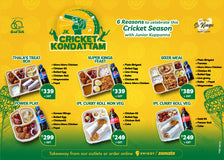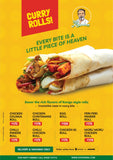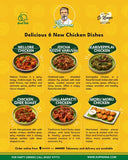All around the world, food has a variety of flavours, but when we think about South India, particularly Tamilnadu, the first word that comes to mind is "Madurai." The town was given the moniker "thoonganagaram" and it is home to more than 100’s of majestic temples and fragrant jasmine blooms. This well-known South Indian temple town is a cultural hub with a lot to offer to traditionalists and modernists alike. It offers a variety of flavours of culture and cuisine that have a great connection with everyone's nose and tongue, even after tasting the food for several years.

The key archaeological monuments, Thalampoo Kumkum, Rail adukku Pathiram, brass idols and vessels, antique and vintage collections of sculptures and paintings, along with monuments, and pottery are the important and most outstanding items that spring to mind when we talk about Madurai.
As much as Madurai is renowned for its vibrantly coloured temples, it is also known for its delicious and authentic street cuisine and for using ancient cooking techniques that entice us with their aroma, flavour, and exquisite taste,especial ly when it comes to non-vegetarian food items. The spicy and tasty Kari dosa, fluffy Kari idlis, crisp and enticing Bun Parrotta, delicious Jigarthanda, and other dishes have had a significant impact on the city's cuisine culture.

When we think of Madurai, the next thing that springs to mind is the mouthwatering, lip-smacking “mutton” treat. When prepared with the genuine flavours of Madurai-based cuisines, this delicious and meaty delicacy is ideal for your taste buds.
All incarnations of mutton are excellent (cooked, of course). Be it braised ribs, a flavorful Asian gravy, a juicy grilled steak, or even keema, which is minced meat that may be prepared in a variety of delectable ways that make you lip-macking.
As Madurai is known as the culinary capital of Tamilnadu, Food has become the centre of an entire industry, with thousands of people employed as waiters, cooks, butchers, traders, and farmers, as well as a vast spice market and the biggest meat market in the southern districts. Although most restaurants include women who supervise the roasting, blending, and grinding of spices or prepare the basic curries, men still predominate in these occupations.
"Sangam Valartha Madurai, Tamizh Valartha Madurai" is mostly Chettinad
cuisine, where mutton plays a significant role in their gastronomic culture.
Anybody who wants to taste mutton that "hits a mark" should travel to Madurai.
Starting with keema, liver fry, mutton gravy, mutton chukka, mutton varuval,
Suvarrotti (goat spleen), Aatukaal soup (mutton soup), Rathaporiyal (goat's blood fry with pepper and salt), mutton biryani, Chettinad mutton pepper varuval, Elumbu Rasam (Goat Bone Rasam), Mutton Kola urundai and many other food varieties added to the list of dishes to taste.

The mutton here is prepared in such a way that tasting it is like dining on food
from heaven. You can savour every single component of the mutton, including the succulent goat spleen pieces, the soft, pounded meat, and the marrow that is extracted from the bones by tapping them.
When addressing all of these delicacies, "Madurai Mutton Curry/Gravy," a royalty dish that truly doesn't need an introduction or particular remark, stands out as the signature dish and the most well-known mutton delicacy that makes a mark here.

When prepared with care, the delicate, succulent mutton and masalas produce a mild, creamy gravy with well-done red meat that was delightfully aromatic and spicy. Although the culinary process is rather simple, the rhythm and fluidity withwhich they create it, together with the harmony in the kitchen, make it obvious that it isn't for everyone.
Cooking in Madurai is known for its liberal use of masalas, which are always freshly ground. The most popular condiments include red chilli, fresh coconut, garlic, tamarind, fenugreek, and curry leaves. Gravies are typically made with star anise, kalpasi, and Marathi moggu, along with different amounts of bay leaves, cinnamon, fennel seeds, black pepper, and poppy seeds.
Vatthal, or salted and sun-dried vegetables and meats, are also utilised as a tribute to the oppressive heat of the area. There's no denying that the majority of South Indian festivals wouldn't be complete without mutton gravy. This flavour-packed, delicious meal, which has its origins in southern Tamilnadu, is a favourite among meat lovers throughout. People who dislike this delicacy are uncommon.
Madurai People also offer goats and fowl as sacrifices to the village god in
accordance with a few ancient Madurai rituals. The butchered goat would be
brought back to its owner's home and butchered there. The remaining meat would be salted and dried to create uppukandam, or jerked meat, which has a long shelf life. Some of the meat would be used to make biryani, mutton curry, varattukari (mutton fry), mutton varuval and mutton chukka also. These would be eaten either cooked in oil as a side dish in a traditional South Indian meal or as a curry to be eaten with rice or even cooked as a flavourful biriyani to be enjoyed by the people gathered in the rituals.

Goats are associated with all of the traditions and way of life of the Madurai people in the same way that Madurai is associated with temples. Goats are used in all of the Madurai people's rituals, from a child's birth to their death. No ritual, whether it is the Aadi month thiruvizha, a puberty celebration, a marriage, a childbirth, or even the after life ceremonies, can be finished without a goat sacrifice.
This doesn't imply that the people of Madurai are impolite and disrespectful, or that every aspect of their culture involves sacrificing family life. Because of their true character, the people of Madurai accept and uphold various traditions in addition to their own. When a stranger arrives in Madurai, he will be greeted with the highest respect. The locals would be extremely kind and compassionate individuals who believe in God and adhere to all local rituals and traditions.






